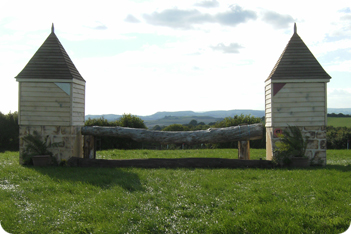
Log Fence
Horse Jumps • Eventing
From: Cross Country Jumps
See also: Horse Jumps • Horse Training • Horse Jump Training

Log Fence
Log fences or tree trunk fences are often one of the most inviting fences on a cross country course, however this does depend on their placement, size and the angle at which you have to jump them.
Log fences can vary greatly in size and shape and can either be jumped on their own or raised so that that the fence is hanging on supports, this type of fence is often to referred to as a "hanging log".
To add to the technical difficulty of the humble log fence they are often used as part of a combination fence and more often than not positioned at an angle or made incredibly narrow to test the accuracy of horse and rider.
Log fences can also used to form a trakehner jump, which is a log jump with a ditch underneath. Of course the size of the ditch and log and its ground placement will determine the difficulty of the fence.
Riding A Log Fence
Most horses enjoy jumping log fences which are often positioned early on in many cross country courses. The majority of logs require good positive riding in a well balanced manner.
If the log is positioned under trees you may need to allow your horse sufficient time to see the fence by taking up a slightly more collected yet positive pace before it.
If the logs are positioned as part of a combination fence then ensure you know the striding in between each fence and the best route for your horse to take, taking into account the ground conditions as well. When you come to ride your fence you will then have a clear line and number of strides in your mind that you need to take for the best chance of success through the combination, however be prepared to adapt because your horse may have its own ideas on how best to continue through the line of fences.
Log fences positioned at the top of a hill or mound, or just after a steep hill or slope will require more skillful riding to ensure that the horse is sufficiently balanced to jump.